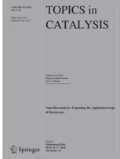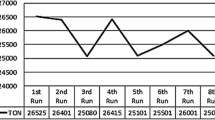Abstract
We report the preparation of rhodium nanoparticles (NPs) stabilized by 1-octadecanethiol (ODT), polyvinyl alcohol (PVA), and tetraoctylammonium bromide (TOAB), and their application for hydrogenation catalysis. The three metal–ligand systems correspond to different mechanism of NPs stabilization via strong covalent linkage, chemisorbed atoms and electrostatic interactions, respectively. We found a strong effect of the interaction between the stabilizer and the surface of the metal nanoparticle on the catalytic activity. The Rh NPs were studied as soluble nanoparticle catalysts and as precursors for the synthesis of supported catalysts. All catalysts were tested in the hydrogenation of cyclohexene under similar conditions as a model reaction. Generally, Rh–ODT NPs were inactive, Rh–PVA NPs exhibited distinct activities in solution (aqueous biphasic catalysis) and as a supported catalyst, and Rh–TOAB NPs exhibited similar activities in solution and after immobilization. This last result opens the opportunity for the preparation of highly active Rh NP catalysts both in solution and as a heterogeneous catalyst. Additionally, the stability of the nanoparticles depends on the choice of ligand and on the functionalization of the support surface before immobilization. By optimizing the catalyst synthesis and reaction conditions, turnover frequencies as high as 700,000 h−1 where observed for stable and recyclable catalyst.





Similar content being viewed by others
References
Ertl G (2008) Handbook of heterogeneous catalysis, 2nd edn. Wiley–VCH, Weinheim
Bell AT (2003) The impact of nanoscience on heterogeneous catalysis. Science 299(5613):1688–1691. doi:10.1126/science.1083671
Rioux RM, Song H, Grass M, Habas S, Niesz K, Hoefelmeyer JD, Yang P, Somorjai GA (2006) Monodisperse platinum nanoparticles of well-defined shape: synthesise characterization, catalytic properties and future prospects. Top Catal 39(3–4):167–174. doi:10.1007/s11244-006-0053-2
Roucoux A, Schulz J, Patin H (2002) Reduced transition metal colloids: a novel family of reusable catalysts? Chem Rev 102(10):3757–3778. doi:10.1021/cr010350j
Somorjai GA, Rioux RM (2005) High technology catalysts towards 100% selectivity fabrication, characterization and reaction studies. Catal Today 100(3–4):201–215. doi:10.1016/j.cattod.2004.07.059
Tian N, Zhou Z-Y, Sun S-G, Ding Y, Wang ZL (2007) Synthesis of tetrahexahedral platinum nanocrystals with high-index facets and high electro-oxidation activity. Science 316(5825):732–735. doi:10.1126/science.1140484
Anderson JA, Fernández Garcia M (2005) Supported metals in catalysis. Imperial College Press, London
Dimitratos N, Lopez-Sanchez JA, Hutchings GJ (2012) Selective liquid phase oxidation with supported metal nanoparticles. Chem Sci 3:20–44. doi:10.1039/c1sc00524c
Brust M, Walker M, Bethell D, Schiffrin DJ, Whyman R (1994) Synthesis of thiol-derivatized gold nanoparticles in a 2-phase liquid–liquid system. J Chem Soc Chem Commun 7:801–802
Chen SW, Huang K, Stearns JA (2000) Alkanethiolate-protected palladium nanoparticles. Chem Mater 12(2):540–547. doi:10.1021/cm9906203
Castro EG, Salvatierra RV, Schreiner WH, Oliveira MM, Zarbin AJG (2010) Dodecanethiol-stabilized platinum nanoparticles obtained by a two-phase method: synthesis, characterization, mechanism of formation, and electrocatalytic properties. Chem Mater 22(2):360–370. doi:10.1021/cm902748k
Hostetler MJ, Zhong CJ, Yen BKH, Anderegg J, Gross SM, Evans ND, Porter M, Murray RW (1998) Stable, monolayer-protected metal alloy clusters. J Am Chem Soc 120(36):9396–9397. doi:10.1021/ja981454n
Sarathy KV, Kulkarni GU, Rao CNR (1997) A novel method of preparing thiol-derivatised nanoparticles of gold, platinum and silver forming superstructures. Chem Commun 6:537–538
Sarathy KV, Raina G, Yadav RT, Kulkarni GU, Rao CNR (1997) Thiol-derivatized nanocrystalline arrays of gold, silver, and platinum. J Phys Chem B 101(48):9876–9880. doi:10.1021/jp971544z
Zhao SY, Chen SH, Wang SY, Li DG, Ma HY (2002) Preparation, phase transfer, and self-assembled monolayers of cubic Pt nanoparticles. Langmuir 18(8):3315–3318. doi:10.1021/la011262x
Yang J, Lee JY, Deivaraj TC, Too HP (2004) A highly efficient phase transfer method for preparing alkylamine-stabilized Ru, Pt, and Au nanoparticles. J Colloid Interface Sci 277(1):95–99. doi:10.1016/j.jcis.2004.03.74
Bile EG, Sassine R, Denicourt-Nowicki A, Launay F, Roucoux A (2011) New ammonium surfactant-stabilized rhodium(0) colloidal suspensions: influence of novel counter-anions on physico-chemical and catalytic properties. Dalton Trans 40(24):6524–6531. doi:10.1039/c0dt01763a
Larpent C, Menn FB-L, Patin H (1991) New highly water-soluble surfactants stabilize colloidal rhodium(O) suspensions useful in biphasic catalysis. J Mol Catal 65:L35–L40
Noel S, Leger B, Herbois R, Ponchel A, Tilloy S, Wenz G, Monflier E (2012) Carboxylated polymers functionalized by cyclodextrins for the stabilization of highly efficient rhodium(0) nanoparticles in aqueous phase catalytic hydrogenation. Dalton Trans 41(43):13359–13363. doi:10.1039/c2dt31596c
Pellegatta JL, Blandy C, Colliere V, Choukroun R, Chaudret B, Cheng P, Philippot K (2002) Catalytic investigation of rhodium nanoparticles in hydrogenation of benzene and phenylacetylene. J Mol Catal A 178(1–2):55–61
Schulz J, Roucoux A, Patin H (1999) Unprecedented efficient hydrogenation of arenes in biphasic liquid–liquid catalysis by re-usable aqueous colloidal suspensions of rhodium. Chem Commun 6:535–536
Yan N, Yuan Y, Dyson PJ (2011) Rhodium nanoparticle catalysts stabilized with a polymer that enhances stability without compromising activity. Chem Commun 47(9):2529–2531. doi:10.1039/c0cc04641h
Dupont J, Fonseca GS, Umpierre AP, Fichtner PFP, Teixeira SR (2002) Transition-metal nanoparticles in imidazolium ionic liquids: recycable catalysts for biphasic hydrogenation reactions. J Am Chem Soc 124(16):4228–4229
Dykeman RR, Yan N, Scopelliti R, Dyson PJ (2011) Enhanced rate of arene hydrogenation with imidazolium functionalized bipyridine stabilized rhodium nanoparticle catalysts. Inorg Chem 50(3):717–719. doi:10.1021/ic102041q
Fonseca GS, Umpierre AP, Fichtner PFP, Teixeira SR, Dupont J (2003) The use of imidazolium ionic liquids for the formation and stabilization of Ir-0 and Rh-0 nanoparticles: efficient catalysts for the hydrogenation of arenes. Chemistry 9(14):3263–3269. doi:10.1002/chem.200304753
Redel E, Kraemer J, Thomann R, Janiak C (2009) Synthesis of Co, Rh and Ir nanoparticles from metal carbonyls in ionic liquids and their use as biphasic liquid–liquid hydrogenation nanocatalysts for cyclohexene. J Organomet Chem 694(7–8):1069–1075. doi:10.1016/j.jorganchem.2008.09.050
Aiken JD, Finke RG (1998) Nanocluster formation synthetic, kinetic, and mechanistic studies. The detection of, and then methods to avoid, hydrogen mass-transfer limitations in the synthesis of polyoxoanion- and tetrabutylammonium-stabilized, near-monodisperse 40 ± 6 angstrom Rh(0) nanoclusters. J Am Chem Soc 120(37):9545–9554. doi:10.1021/ja9719485
Aiken JD, Finke RG (1999) Polyoxoanion- and tetrabutylammonium-stabilized Rh(0)(n) nanoclusters: unprecedented nanocluster catalytic lifetime in solution. J Am Chem Soc 121(38):8803–8810
Aiken JD, Finke RG (1999) Polyoxoanion- and tetrabutylammonium-stabilized, near-monodisperse, 40 ± 6 angstrom Rh(0) similar to (1500) to Rh(0) similar to (3700) nanoclusters: synthesis, characterization, and hydrogenation catalysis. Chem Mater 11(4):1035–1047. doi:10.1021/cm980699w
Li Y, El-Sayed MA (2001) The effect of stabilizers on the catalytic activity and stability of Pd colloidal nanoparticles in the Suzuki reactions in aqueous solution. J Phys Chem B 105(37):8938–8943. doi:10.1021/jp010904m
Stowell CA, Korgel BA (2005) Iridium nanocrystal synthesis and surface coating-dependent catalytic activity. Nano Lett 5(7):1203–1207. doi:10.1021/nl050648f
Narayanan R, El-Sayed MA (2003) Effect of catalysis on the stability of metallic nanoparticles: suzuki reaction catalyzed by PVP-palladium nanoparticles. J Am Chem Soc 125(27):8340–8347. doi:10.1021/ja035044x
Sonstroem P, Arndt D, Wang X, Zielasek V, Baeumer M (2011) Ligand capping of colloidally synthesized nanoparticles-a way to tune metal-support interactions in heterogeneous gas-phase catalysis. Angew Chem Int Ed Engl 50(17):3888–3891. doi:10.1002/anie.201004573
Kesavan L, Tiruvalam R, Rahim MHA, Saiman MIB, Enache DI, Jenkins RL, Dimitratos N, Lopez-Sanchez JA, Taylor SH, Knight DW, Kiely CJ, Hutchings GJ (2011) Solvent-free oxidation of primary carbon-hydrogen bonds in toluene using Au-Pd alloy nanoparticles. Science 331(6014):195–199. doi:10.1126/science.1198458
Lopez-Sanchez JA, Dimitratos N, Hammond C, Brett GL, Kesavan L, White S, Miedziak P, Tiruvalam R, Jenkins RL, Carley AF, Knight D, Kiely CJ, Hutchings GJ (2011) Facile removal of stabilizer-ligands from supported gold nanoparticles. Nat Chem 3(7):551–556. doi:10.1038/nchem.1066
Boennemann H, Endruschat U, Hormes J, Koehl G, Kruse S, Modrow H, Moertel R, Nagabhushana KS (2004) Activation of colloidal PtRu fuel cell catalysts via a thermal “conditioning process”. Fuel Cells 4(4):297–308. doi:10.1002/fuce.200400032
Jacinto MJ, Kiyohara PK, Masunaga SH, Jardim RF, Rossi LM (2008) Recoverable rhodium nanoparticles: synthesis, characterization and catalytic performance in hydrogenation reactions. Appl Catal A 338(1–2):52–57
Deng YQ, Nevell TG, Ewen RJ, Honeybourne CL, Jones MG (1993) Sulfur poisoning, recovery and related phenomena over supported palladium, rhodium and iridium catalysts for methane oxidation. Appl Catal A 101(1):51–62. doi:10.1016/0926-860x(93)80137-f
Umpierre AP, de Jesus E, Dupont J (2011) Turnover numbers and soluble metal nanoparticles. Chemcatchem 3(9):1413–1418. doi:10.1002/cctc.201100159
Thomas KG, Kamat PV (2000) Making gold nanoparticles glow: enhanced emission from a surface-bound fluoroprobe. J Am Chem Soc 122(11):2655–2656. doi:10.1021/ja9941835
Thomas KG, Zajicek J, Kamat PV (2002) Surface binding properties of tetraoctylammonium bromide-capped gold nanoparticles. Langmuir 18(9):3722–3727. doi:10.1021/la015669d
Costa NJS, Rossi LM (2012) Synthesis of supported metal nanoparticle catalysts using ligand assisted methods. Nanoscale 4(19):5826–5834. doi:10.1039/c2nr31165h
Oliveira RL, Zanchet D, Kiyohara PK, Rossi LM (2011) On the stabilization of gold nanoparticles over silica-based magnetic supports modified with organosilanes. Chemistry 17(16):4626–4631. doi:10.1002/chem.201002251
Jacinto MJ, Silva FP, Kiyohara PK, Landers R, Rossi LM (2012) Catalyst recovery and recycling facilitated by magnetic separation: iridium and other metal nanoparticles. Chemcatchem 4(5):698–703. doi:10.1002/cctc.201100415
Rossi LM, Nangoi IM, Costa NJS (2009) Ligand-assisted preparation of palladium supported nanoparticles: a step toward size control. Inorg Chem 48(11):4640–4642
Jacinto MJ, Landers R, Rossi LM (2009) Preparation of supported Pt(0) nanoparticles as efficient recyclable catalysts for hydrogenation of alkenes and ketones. Catal Commun 10(15):1971–1974
Acknowledgments
The authors are grateful to INCT-Catalise and the Brazilian government agencies FAPESP and CNPq for financial support. We also acknowledge LNNano (Campinas, Brazil) for the use of TEM facilities.
Author information
Authors and Affiliations
Corresponding author
Electronic supplementary material
Below is the link to the electronic supplementary material.
Rights and permissions
About this article
Cite this article
Rossi, L.M., Vono, L.L.R., Garcia, M.A.S. et al. Screening of Soluble Rhodium Nanoparticles as Precursor for Highly Active Hydrogenation Catalysts: The Effect of the Stabilizing Agents. Top Catal 56, 1228–1238 (2013). https://doi.org/10.1007/s11244-013-0089-z
Published:
Issue Date:
DOI: https://doi.org/10.1007/s11244-013-0089-z




